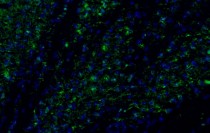ARG56551
anti-CCL2 / MCP1 antibody
anti-CCL2 / MCP1 antibody for ELISA,IHC-Formalin-fixed paraffin-embedded sections,Neutralizing,Western blot and Mouse
Overview
| Product Description | Rabbit Polyclonal antibody recognizes CCL2 / MCP1 |
|---|---|
| Tested Reactivity | Ms |
| Tested Application | ELISA, IHC-P, Neut, WB |
| Host | Rabbit |
| Clonality | Polyclonal |
| Isotype | IgG |
| Target Name | CCL2 / MCP1 |
| Antigen Species | Mouse |
| Immunogen | E. coli derived recombinant Mouse CCL2 / MCP1. |
| Conjugation | Un-conjugated |
| Alternate Names | MCP1; AI323594; MCAF; Monocyte chemotactic protein 1; Sigje; Small-inducible cytokine A2; Platelet-derived growth factor-inducible protein JE; HC11; SMC-CF; JE; Scya2; C-C motif chemokine 2; Monocyte chemoattractant protein 1; MCP-1 |
Application Instructions
| Application Suggestion |
|
||||||||||
|---|---|---|---|---|---|---|---|---|---|---|---|
| Application Note | * The dilutions indicate recommended starting dilutions and the optimal dilutions or concentrations should be determined by the scientist. |
Properties
| Form | Liquid |
|---|---|
| Purification | Affinity purification with immunogen. |
| Buffer | PBS (pH 7.2) |
| Concentration | 1 mg/ml |
| Storage Instruction | For continuous use, store undiluted antibody at 2-8°C for up to a week. For long-term storage, aliquot and store at -20°C. Storage in frost free freezers is not recommended. Avoid repeated freeze/thaw cycles. Suggest spin the vial prior to opening. The antibody solution should be gently mixed before use. |
| Note | For laboratory research only, not for drug, diagnostic or other use. |
Bioinformation
| Database Links | |
|---|---|
| Gene Symbol | Ccl2 |
| Gene Full Name | chemokine (C-C motif) ligand 2 |
| Background | This gene is one of several cytokine genes clustered on chromosome 11. Chemokines are a superfamily of secreted proteins involved in immunoregulatory and inflammatory processes. The superfamily is divided into four subfamilies based on the arrangement of N-terminal cysteine residues of the mature peptide. This chemokine is a member of the CC subfamily which is characterized by two adjacent cysteine residues. This cytokine displays chemotactic activity for monocytes and memory T cells but not for neutrophils. The human ortholog has been implicated in the pathogenesis of diseases characterized by monocytic infiltrates, such as psoriasis, rheumatoid arthritis, and atherosclerosis. [provided by RefSeq, Sep 2015] |
| Function | Chemotactic factor that attracts monocytes, but not neutrophils. [UniProt] |
| Highlight | Related products: MCP1 antibodies; MCP1 ELISA Kits; MCP1 Duos / Panels; Anti-Rabbit IgG secondary antibodies; Related news: HMGB1 in inflammation Inflammatory Cytokines |
| Calculated MW | 11 kDa |
| PTM | Processing at the N-terminus can regulate receptor and target cell selectivity. Deletion of the N-terminal residue converts it from an activator of basophil to an eosinophil chemoattractant. |
Images (4) Click the Picture to Zoom In
-
ARG56551 anti-CCL2 / MCP1 antibody IHC image
Immunohistochemistry: This antibody stained colchicine injected Mouse brain (including caudate putamen) tissue. The primary antibody ARG56551 anti-CCL2 / MCP1 antibody was incubated at 1.0 µg/ml overnight at 4˚C. This was followed by a peroxidase conjugated secondary antibody and then a fluorescein Tyramide Signal Amplification reagent.
-
ARG56551 anti-CCL2 / MCP1 antibody WB image
Western blot: 250 - 0.24 ng (left to right) of recombinant Mouse MCP-1 stained with ARG56551 anti-CCL2 / MCP1 antibody. (Under non-reducing conditions)
-
ARG56551 anti-CCL2 / MCP1 antibody standard curve image
ARG56551 anti-CCL2 / MCP1 antibody results of a typical standard run with optical density reading at 405 - 650 nm.
-
ARG56551 anti-CCL2 / MCP1 antibody WB image
Western blot: 250 - 0.24 ng (left to right) of recombinant Mouse MCP-1 stained with ARG56551 anti-CCL2 / MCP1 antibody. (Under reducing conditions)











